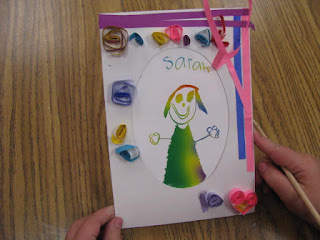Ah, Payons! If you've taught a while, you remember these gems. Always hard. Stuck in the black cardboard tubes, then suddenly (without warning) slipping out and you'd find them later in a water cup. They stained EVERYTHING. Most art teachers I know got rid of them. But I am not a person who gets rid of everything (see any previous posts where I speak of my hoarding ways). So, I have a box full of them in my painting cabinet (they were here when I came 9 years ago).
This morning we were in our collaboration group and another art teacher was sharing how she's using water soluble oil pastels with styrofoam. She has them "carve" their styrofoam with a dull pencil, then color the styrofoam with water soluble oil pastels, lightly spritz their papers with water and print. It works wonderfully, there's more blending and color gradation and they can print several times before they recolor. Only I don't have any water soluble oil pastels. I have Payons. So I tried it, and it worked:
 |
I just used scrap styrofoam that I had.
It's just a design, not a word
(although it looks a bit like one here) |
While we were all working someone asked "I wonder if these oil pastels would work on Gelli Plates?" We tried, and it didn't work at all. But Payons did! They create a beautiful watercolor effect when you dip the Payons in water, draw directly on the Gelli Plate and pull the print:
In case you don't know this about me, I LOVE my Gelli Plates. I make Gelli art all the time at home (so I'm totally taking a box or two of old Payons home with me tonight!)
Unlike LL Cool J, I'm totally calling this a comeback for Payons! (And their performance may just knock you out!)
 |
See how the yellow Payon stained the Gelli Plate?
It's not a big deal. |




















































